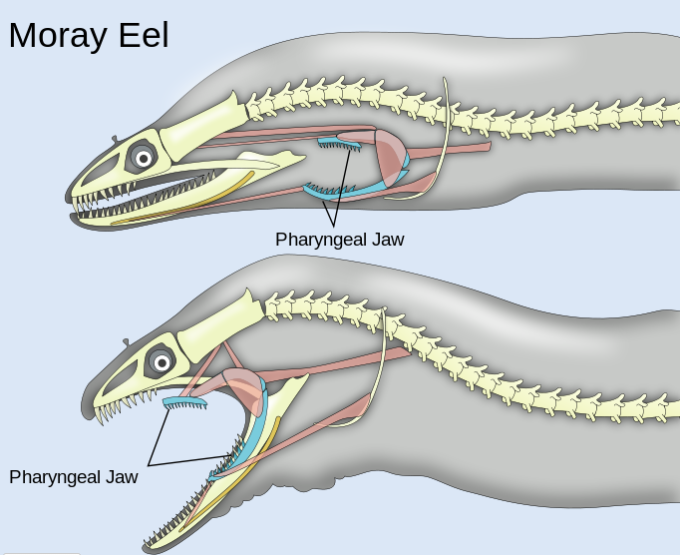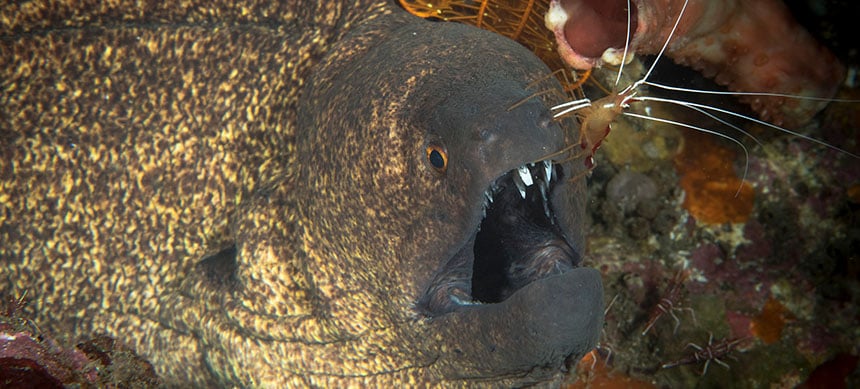You can find moray eels worldwide and they are a common underwater sight. But they are fascinating animals and this is your chance to learn some amazing facts you probably didn’t know about moray eels.
The weird look
Many people feel that an eel’s open mouth gives them a threating look. For us at Master Liveaboards, it looks like they just told a joke and they are waiting for a reaction. 😉

The truth is that they are just breathing. Moray eels don’t have bony gill covers on their sides; instead they use their mouths to orally pump water through the two circular openings they have behind their head.
The alien jaws
Ridley Scott might well have been inspired by a moray eel when he created the creature for the movie, Alien. Do you remember the scene where the second set of jaws come out when the queen is face to face with Sigourney Weaver? Well, morays have a hidden set of internal jaws too.

Inside the gullet, there are a pair of concealed ‘pharyngeal jaws’ that help morays entrap their prey. Whilst most predatory fish use suction to pull food down their throats, morays instead have a two-step strategy. First, the outer jaws firmly grip the prey. Then, the pharyngeal jaw shoots forwards, bites the unfortunate victim, and pulls it into the throat. Fun, no?
One of the best, if not THE best, of all our amazing facts about moray eels!
They are kind of blind
Have you ever noticed the 2 small appendages on moray eels noses? These are their nostrils. Due to their relatively poor eyesight, moray eels rely on their keen sense of smell to hunt.

They are renowned for their ability to strike at lightning fast speed at night. Their favourite choice of prey is usually weakened or dead too. When you can’t see well, it’s much easier to detect and catch if you have a good nose. That’s why moray eels are great reef cleaners of dead fish.
Giant morays join forces with other species to hunt
As you can read in this article, giant morays often hunt in tandem with groupers. Whereas morays are slim and ambush hunters, groupers are speedy killers. Each fish complements the other’s talents perfectly: With the moray wriggling through the reef and the grouper hovering overhead, their respective prey have nowhere to hide.
They kind of like to put make up on!

Moray eels often appear to be green, but in fact they’re brown. They secrete a mucus over their smooth skin to protect them from scratches that can occurred due to their rapid sliding movements around the reef. This mucus has a yellow hue that changes the color of their skin. The coating also contains various toxins, including one which destroys red blood cells.
Morays are not snakes
While many of us might think this is obvious, you’ll be surprised how often our crews are asked whether morays are, in fact, a type of snake. To be fair, they do have a kind of snake-like look about them. Despite this, morays are neither reptiles nor amphibians, they are real fish.

The confusion arises because morays lack both pelvic and pectoral fins, with only the one long fin running from the head, around the tail, and along the belly. Although this appears to be one fin, it is in fact three: a fusion of the eel’s dorsal, caudal, and anal fins.
There are roughly 200 known species
Morays are split into two main divisions; true morays and snake morays (yes yes, we know, they’re not really snakes). Divers can differentiate them by looking at their one long fin. On a true moray, the fin starts just behind the gills, with the appendage limited to the tail region only in snake morays.

According to the World Register of Marine Species, there are currently 202 species of morays between these two types.
Thank you for reading this far. Now, next time you see or photograph one of these 202 species, you will be able to wow your dive buddies with our interesting facts about morays.



